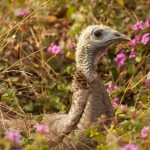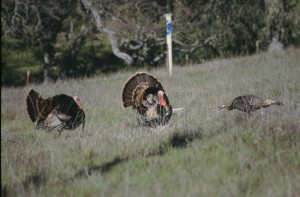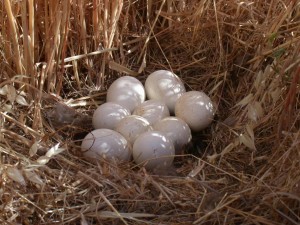This week, as your thoughts turn to roasted turkey with all the trimmings, take a moment to ponder the beast in your feast. While domesticated turkeys are only a few hundred years removed from their wild brethren, behaviorally they are quite different. The wild turkey has a sophisticated social system that rivals that of lions or primates.
Note: an edited version of this appears (or will soon appear) on the Ethogram, an outreach blog for the Animal Behavior Graduate Group at the University of California Davis.
Let’s start with the wild turkey’s breeding system. Unlike about 90% of birds, in turkeys there’s no bond between males and females. In fact, the breeding system defies most traditional organization schemes biologists have proposed, falling somewhere between harem defense in which one male can guard several females (think a big bull elk and his female herd), and a lek mating system where a female can choose among several males. Female turkeys may be attended by a team of two or more males who act together to try to woo the hens and keep other males away; other teams or solitary males also may orbit the female flock as it wanders around. More on these teams below.
The females are far from passive players in all of this. Turkey hens can, and do, mate with more than one male. For more on what females are looking for in a mate, check out the work of Dr. Richard Buchholz, including a recent summary airing on Science Friday (Spoiler Alert: it’s all in the snood). Wild turkeys are also intraspecific brood parasites, meaning one female can lay an egg in the nest of another female of her own species to raise. Putting all this together, the poults (chicks) from a turkey nest can be any combination of full siblings, maternal half-siblings by a female mating with two or more males, unrelated nest-mates from another female’s eggs, and even occasional paternal half-siblings if the other female mated with the same male! And you thought your family was complicated… In spite of all this variety, overall about half of nests in a Carmel Valley study[1] resulted from only one female mating with one male, and the completely unrelated offspring in a nest were pretty rare.
The fact that most poults in a nest are usually close relatives becomes important for the next part of the story– what’s going on with those teams of males. Why one animal should help another is one of the fundamental questions of evolutionary biology- shouldn’t males be trying as hard as they can to pass as many of their own genes into the next generation? In the 1960’s, PhD student Charles Watts, working in a Texas turkey population, proposed a solution involving a newly emergent concept called kin selection [2]. If the turkey teams were composed of brothers, these males would share many of the same copies of their genes because they are from the same parents. Thus even if one of the brothers fails to mate, he can still pass on portions of his genome by helping his closely related teammate to reproduce. However, Watts’ evidence for kin selection was circumstantial, attempts to replicate the study failed, and eventually Watts’ own committee member published a scathing critique of the idea [3].
Here are two videos showing both the cooperative courtship of males and the defense of females.
Confirmation of the kin selection hypothesis for cooperation in male turkeys had to wait almost 40 years. With the advent of DNA analysis that allows researchers to figure out which males were passing on their genes, as well as whether males were related or not, it was finally possible to test whether having team-mates leads to more offspring for males, and whether the teams are close kin. When the genetic data were analyzed [4], it was found on average that at most one male per coalition was able to mate, but that on average these males fathered several times as many offspring as solitary males who didn’t have a helping team-mate. Additionally, these coalitions were related on average between the level of half- and full brothers. These observations provided all the information necessary to evaluate Hamilton’s Rule, the simple cost-benefit equation proposed by famous evolutionary biologist William Hamilton to determine whether the gain in indirect reproduction (i.e. that gained by helping relatives reproduce more) is enough to offset losses to an individual’s own reproduction. For the male turkeys, it turns out the subordinate, non-breeding teammates actually pass on more gene copies by helping their close relative to reproduce than if they left the team and went off on their own to try their hand at solitary display. With this result, turkeys provide a powerful example of how even counter-intuitive behaviors like self-sacrifice can evolve.
Summing all this up, wild turkeys live in societies that feature both intense competition and surprising cooperation among males, along with a host of female mating and egg-laying strategies. Tantalizing anecdotes point to even further layers of complexity in how turkey populations are organized. Watts observed occasional battles between large flocks of turkeys; a more recent observation of this phenomenon described it using a West Side Story analogy, as if the “Sharks and Jets” were facing off. Unfortunately these events are so rare that we don’t yet know how they are organized or what the fight is all about. Regardless, turkeys have a lot to teach us about how and why animals do the things they do.
[1] Krakauer, A.H. 2008. Sexual selection and the genetic mating system of Wild Turkeys. Condor 110(1): 1-12. [link to journal]
[2] Watts, C.R and A.W. Stokes. 1971. The social order of turkeys. Scientific American 224: 112-118.
[3] Balph,D.F., Innis, G.S., and Balph, M.H. 1980. Kin selection in Rio Grande turkeys: A critical assessment. Auk 97(4): 854-860. [link to journal]
[4] Krakauer, A.H. 2005. Kin selection and cooperative courtship in wild turkeys. Nature 434: 69-72. [link to journal]




